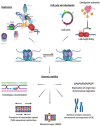The Amazing Acrobat: Yeast's Histone H3K56 Juggles Several Important Roles While Maintaining Perfect Balance
- PMID: 33668997
- PMCID: PMC7996553
- DOI: 10.3390/genes12030342
The Amazing Acrobat: Yeast's Histone H3K56 Juggles Several Important Roles While Maintaining Perfect Balance
Abstract
Acetylation on lysine 56 of histone H3 of the yeast Saccharomyces cerevisiae has been implicated in many cellular processes that affect genome stability. Despite being the object of much research, the complete scope of the roles played by K56 acetylation is not fully understood even today. The acetylation is put in place at the S-phase of the cell cycle, in order to flag newly synthesized histones that are incorporated during DNA replication. The signal is removed by two redundant deacetylases, Hst3 and Hst4, at the entry to G2/M phase. Its crucial location, at the entry and exit points of the DNA into and out of the nucleosome, makes this a central modification, and dictates that if acetylation and deacetylation are not well concerted and executed in a timely fashion, severe genomic instability arises. In this review, we explore the wealth of information available on the many roles played by H3K56 acetylation and the deacetylases Hst3 and Hst4 in DNA replication and repair.
Keywords: DNA repair; DNA replication; Hst3; Hst4; acetylation/deacetylation; chromatin; genome stability.
Conflict of interest statement
The authors declare no conflict of interest.
Figures


Similar articles
-
Interplay between histone H3 lysine 56 deacetylation and chromatin modifiers in response to DNA damage.Genetics. 2015 May;200(1):185-205. doi: 10.1534/genetics.115.175919. Epub 2015 Mar 18. Genetics. 2015. PMID: 25786853 Free PMC article.
-
Hst3 and Hst4 histone deacetylases regulate replicative lifespan by preventing genome instability in Saccharomyces cerevisiae.Genes Cells. 2011 Apr;16(4):467-77. doi: 10.1111/j.1365-2443.2011.01493.x. Epub 2011 Mar 15. Genes Cells. 2011. PMID: 21401809
-
A reversible histone H3 acetylation cooperates with mismatch repair and replicative polymerases in maintaining genome stability.PLoS Genet. 2013 Oct;9(10):e1003899. doi: 10.1371/journal.pgen.1003899. Epub 2013 Oct 24. PLoS Genet. 2013. PMID: 24204308 Free PMC article.
-
Histone H3 lysine 56 acetylation: a new twist in the chromosome cycle.Cell Cycle. 2006 Nov;5(22):2602-8. doi: 10.4161/cc.5.22.3473. Epub 2006 Nov 15. Cell Cycle. 2006. PMID: 17172838 Review.
-
Histones on fire: the effect of Dun1 and Mrc1 on origin firing and replication of hyper-acetylated genomes.Curr Genet. 2021 Aug;67(4):501-510. doi: 10.1007/s00294-021-01175-2. Epub 2021 Mar 14. Curr Genet. 2021. PMID: 33715066 Review.
Cited by
-
Suppressor mutations that make the essential transcription factor Spn1/Iws1 dispensable in Saccharomyces cerevisiae.Genetics. 2022 Sep 30;222(2):iyac125. doi: 10.1093/genetics/iyac125. Genetics. 2022. PMID: 35977387 Free PMC article.
-
The Central FacilitaTOR: Coordinating Transcription and Translation in Eukaryotes.Int J Mol Sci. 2025 Mar 21;26(7):2845. doi: 10.3390/ijms26072845. Int J Mol Sci. 2025. PMID: 40243440 Free PMC article. Review.
-
PCNA Loaders and Unloaders-One Ring That Rules Them All.Genes (Basel). 2021 Nov 18;12(11):1812. doi: 10.3390/genes12111812. Genes (Basel). 2021. PMID: 34828416 Free PMC article. Review.
-
An epigenetically inherited UV hyper-resistance phenotype in Saccharomyces cerevisiae.Epigenetics Chromatin. 2022 Aug 20;15(1):31. doi: 10.1186/s13072-022-00464-5. Epigenetics Chromatin. 2022. PMID: 35986361 Free PMC article.
-
Chromatin assembly factor-1 preserves genome stability in ctf4Δ cells by promoting sister chromatid cohesion.Cell Stress. 2023 Aug 14;7(9):69-89. doi: 10.15698/cst2023.09.289. eCollection 2023 Sep 11. Cell Stress. 2023. PMID: 37662646 Free PMC article.
References
-
- Fillingham J., Recht J., Silva A.C., Suter B., Emili A., Stagljar I., Krogan N.J., Allis C.D., Keogh M.C., Greenblatt J.F. Chaperone control of the activity and specificity of the histone H3 acetyltransferase Rtt109. Mol. Cell. Biol. 2008;28:4342–4353. doi: 10.1128/MCB.00182-08. - DOI - PMC - PubMed
Publication types
MeSH terms
Substances
LinkOut - more resources
Full Text Sources
Other Literature Sources
Molecular Biology Databases

